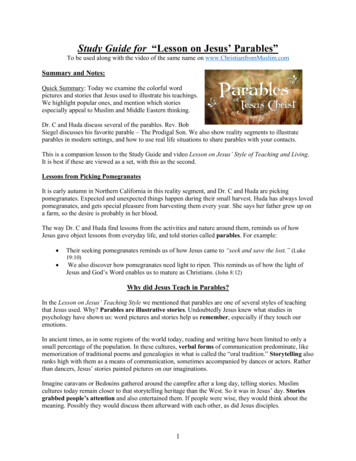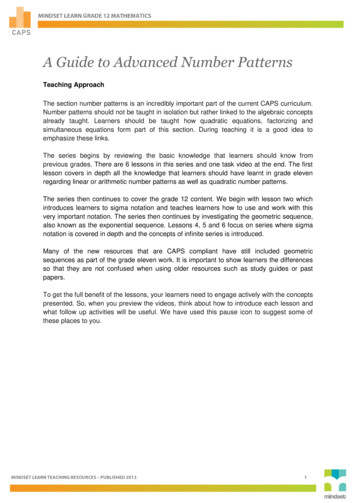
Transcription
Study Guide for “Lesson on Jesus’ Parables”To be used along with the video of the same name on www.ChristianfromMuslim.comSummary and Notes:Quick Summary: Today we examine the colorful wordpictures and stories that Jesus used to illustrate his teachings.We highlight popular ones, and mention which storiesespecially appeal to Muslim and Middle Eastern thinking.Dr. C and Huda discuss several of the parables. Rev. BobSiegel discusses his favorite parable – The Prodigal Son. We also show reality segments to illustrateparables in modern settings, and how to use real life situations to share parables with your contacts.This is a companion lesson to the Study Guide and video Lesson on Jesus’ Style of Teaching and Living.It is best if these are viewed as a set, with this as the second.Lessons from Picking PomegranatesIt is early autumn in Northern California in this reality segment, and Dr. C and Huda are pickingpomegranates. Expected and unexpected things happen during their small harvest. Huda has always lovedpomegranates, and gets special pleasure from harvesting them every year. She says her father grew up ona farm, so the desire is probably in her blood.The way Dr. C and Huda find lessons from the activities and nature around them, reminds us of howJesus gave object lessons from everyday life, and told stories called parables. For example: Their seeking pomegranates reminds us of how Jesus came to “seek and save the lost.” (Luke19:10)We also discover how pomegranates need light to ripen. This reminds us of how the light ofJesus and God’s Word enables us to mature as Christians. (John 8:12)Why did Jesus Teach in Parables?In the Lesson on Jesus’ Teaching Style we mentioned that parables are one of several styles of teachingthat Jesus used. Why? Parables are illustrative stories. Undoubtedly Jesus knew what studies inpsychology have shown us: word pictures and stories help us remember, especially if they touch ouremotions.In ancient times, as in some regions of the world today, reading and writing have been limited to only asmall percentage of the population. In these cultures, verbal forms of communication predominate, likememorization of traditional poems and genealogies in what is called the “oral tradition.” Storytelling alsoranks high with them as a means of communication, sometimes accompanied by dances or actors. Ratherthan dancers, Jesus’ stories painted pictures on our imaginations.Imagine caravans or Bedouins gathered around the campfire after a long day, telling stories. Muslimcultures today remain closer to that storytelling heritage than the West. So it was in Jesus’ day. Storiesgrabbed people’s attention and also entertained them. If people were wise, they would think about themeaning. Possibly they would discuss them afterward with each other, as did Jesus disciples.1
Agatha Christie, the third best-selling author of all time, after the Bible and Shakespeare, made aninteresting observation. While working with her archaeologist husband on an archaeological dig in Syriashe noticed,“The New Testament comes very near when I ask Max to repeat the gist of long conversationsthat he has had with the Sheikh, for their exchanges consist almost entirely of parables- toillustrate your wishes or your demands, you tell a story with a point to it, the other counters withanother story which turns the tables, and so on. Nothing is ever couched in direct language.”Although this describes communication from the 1930s, Dr. Cynthia has found that even today, a greatway to engage the attention of many Muslims is with a story parable. Although we tend to overlook it,stories often work with Westerners too, as shown by the popularity of novels and movies.Jesus’ Teaching: Similes and MetaphorsWhile sitting in a gazebo surrounded by a beautiful lake, Dr. C explains to Huda that a common wayJesus taught was with metaphors. He also used similes. A metaphor is saying that something is something else – something that it is not, but has qualitiesin common with. A simile is stating that something is like, or similar to something else.o Parables often start with a simile, saying for example that, “The Kingdom of God islike ”Example of Metaphors – SALT and LIGHTJesus said that: We are the salt of the earth. (Matthew 5:13) Why is that important? Think:ooo Salt brings flavor to bland food – and we should bring good flavor to the world!Salt preserves meat from rotting – so Christians preserve society from rotting.Salt was, and at times still is, used for healing – so Christians should be healing in what we sayand do!He is the light of the world. Why is that important? Think: (John 8:12)oooWithout light we stumble in darkness.Light brings warmth in a cold world.Seen shining in sunlight, the world is a beautiful place. This cheers us.Reality – Visiting a Lighthouse: To demonstrate the importance of light as a guide, Dr. C visits alighthouse on the Northern California coast. She points out as how the lighthouse saves lives by givingships at sea knowledge of where the land is. So to us light is what directs us through the darkness andfogs of this world.LIGHT is a common and powerful image used throughout the Bible to describe how God’s waykeeps us out of darkness. We discuss this also in the lesson on Christmas, because that is when the truelight came into the world. Since we think that Light is very meaningful, we would like to share a fewmore examples of Bible verses on “light.” You will notice that many are from John’s gospel or letters.Light in the OLD TESTAMENT – God’s WordYour word is a lamp for my feet, a light on my path.2Psalm 119: 105
The light of the righteous shines brightly, but the lamp of the wicked is snuffed out. Proverbs 13:9Light in the NEW TESTAMENT - JesusAnd the judgment is based on this fact: God’s light came into the world,but people loved the darkness more than the light, for their actions were evil. John 3:19 NLTThis is the message we have heard from him and declare to you: God is light; in him there is nodarkness at all. If we claim to have fellowship with him and yet walk in the darkness, we lie anddo not live out the truth. But if we walk in the light, as he is in the light, we have fellowship withone another, and the blood of Jesus, his Son, purifies us from all sin.I John 1:5-7May we always walk in the light, with Jesus, our Savior.Risks of OverinterpretingParables, Similes and MetaphorsParables, metaphors and similes are analogies. This means they are something used to describesomething else. Analogies have limitations. Good ones illustrate in a powerful and memorable way. Butall analogies break down at some point. This means that not everything about them exactly mirrors what they illustrate. Some analogies fit better than others. The important thing is their strength in illustrating ourpoint. “Leave a good thing alone” is a saying we have in English which means not to risk ruiningsomething by overdoing it. That applies to analogies as well.Example - Common analogies Christians use:An egg, the Irish shamrock, and the phases of water are common illustrations of the Trinity – becausethey are three in one like God. But these analogies break down at some point, because obviously God isidentical to none of them. For example, the egg has membranes dividing its parts, and a shell made ofcalcium, which God is not, and so on.Example – Using the Empty Glass Analogy:Muslims have difficulty understanding how God could be Jesus. Some obstacle keeps them from seeingthat God can be inside Jesus and outside at the same time. They challenge us by asking,“If God was in Jesus who was watching the world?”Sometimes they ridicule us when saying this, as if they caught us being stupid in thinking that God couldbe limited to a body. Yet the question is almost humorous to longtime Christians, because we acceptautomatically that God is always everywhere because he is omnipresent. David tells us this in Psalm 139.(Note: It may surprise Christians that Muslims are not sure that Allah is everywhere at once.)How do we answer? First we remind them that God was in the burning bush and outside it at the sametime. The Qur’an says this as well as the Bible. Then we remind them that Jesus is “God in human flesh.”3
Dr. C likes to point to an empty or partly filled glass as an illustration of the incarnation – Godbecoming man in Jesus Christ. Many times we are sitting with Muslims eating or drinking, as fits withtheir hospitable culture. So usually an empty glass of water, and a partly filled cup of tea or coffee are thetable. We can use those for an easy illustration.Just as air is both inside and outside the empty glass at the same time,so God was inside the human body of Jesus as well as everywhere else.If we leave the analogy at that, it is powerful and gives them something to think about. The fact that theysaw it on the table helps make it memorable. But we keep the illustration simply to the analogy of wherethe air is. We don’t overinterpret it by referring to what is in the cup, or say that the Holy Spirit is like thecaffeine in coffee, or worry about other cups on the table. Short and sharp make it memorable.(Note: This is an example of using everyday things and situations that we encourage you to do in sharingGod’s truth with Muslims and others. Keep your eyes open for other examples.)Parables and Metaphors in the GospelsThe First Three GospelsHave you noticed that the first three gospels in the New Testament are similar? That is because they usedsimilar eyewitness testimonies to tell their stories of the life of Jesus (synoptic). Some people ask whythere were three if they were so similar? Each gospel has a slightly different slant and length. This is because of the people groups thatthey were written for.The gospels were not all circulated in the same location, for example, Mark went to Alexandria,Egypt as a missionary, where his gospel was mainly used.Matthew is especially focused on fulfilled prophecies. It is felt that is because he wrote for theJews. He included many of Jesus’ metaphors in the most complete Sermon on the Mountrecorded.Luke is especially thorough on including parables.Mark, felt to be directed to the Romans, is shorter, action oriented, and includes the emotionaccompanying the events.The Gospel of JohnQUESTION: The Gospel of John, comes after Matthew, Mark, and Luke in the New testament. Manypeople have noticed that it is very different than the first three and have wondered why?ANSWER; The early church historian Eusebius explained it for us. Within a few decades after Jesus’resurrection the first three gospels were written. They were good descriptions of what Jesus did and said.But Eusebius tells us that decades later, some believers approached Jesus’ disciple John. They knew hehad a unique view, focused on love and other spiritual aspects of the Christian life, as we can see from thethree letters he wrote in the New Testament. They asked John to write a “spiritual gospel.”When we think of it that way, it makes sense why John’s approach is so different. He was not asconcerned with as many of the different activities and miracles that Jesus did compared to the other threegospel writers. He was much more focused on the spiritual discussions that Jesus had, the symbolismand metaphors.John’s gospel has some of the best metaphorical descriptions of Jesus. For example,4
the Word of Godthe light of the worldthe bread of lifethe source of living waterthe resurrection and the lifethe Good Shepherdthe doorthe waythe truththe lifeTeaching: CONTEXTWhen interpreting a parable – or anything Jesus taught – we should consider it in the context he waspresenting the parable in. If we dig a little to uncover the setting Jesus was speaking in or about, Jesus’teaching takes on more power.Examples of Jesus’ Teaching in Context: Living Water.o When he offered living water to a woman in Samaria, they were seated by a well,drawing water. (John 4)o When Jesus invited the spiritually thirsty to come to him, he was in the temple during theFeast of Tabernacles. Water was an important part of this festival.§ Jesus was likely standing near the water gate. The people would see the waterflowing forth, so when he spoke about spiritual water, the impact would beunforgettable. (John 7:2,37,38) Light of the World. When Jesus said he was the Light of the World in John 8:12, he was likelynear candlesticks in the temple during the Feast of Hanukkah, which was a festival of lights.These lights behind him would hold the people’s attention as he announced that he was the light.Then they must all have turned their eyes to him, amazed! Bread of Life. Jesus’ claim to be the Bread of Life came just after he fed bread to over 5,000people in John 6. The Resurrection and the Life. Jesus arrived at the home of Mary and Martha to mourn withthem after their brother Lazarus had died. They were severely disappointed by Jesus’ late arrival,for they had hoped Jesus would heal him.Jesus told her, “I am the resurrection and the life. Anyone who believes in me will live,even after dying. Everyone who lives in me and believes in me will never ever die. Do youbelieve this, Martha?” John 11:25,26 NLToJesus could have claimed any day to be the resurrection and the life. But oImagine how you would feel if you had just lost a loved one. Hearing this message whenthe despair of death was upon them, made the promise of resurrection especially hopefulto Mary, Martha, and their gathered friends.o After making this bold claim, Jesus actually raised Lazarus from the dead! What a way toprove his point!5
Reality – Eating Bread: In this reality segment Huda and Dr. C share a lunch of tasty homemade soupand Middle Eastern bread. Bread has been called the staff of life, because of its great importance as a foodin many cultures. Dr. C points to Bible verses written on her wall, which mention food. One is from Job.The Prophet Job suffered very greatly in the Old Testament (and the Qur’an). In trying to provehis innocence to the friends who accused him of being punished for his evil, he used bread to express howimportant God’s words were to him. Job said,“I have not departed from the commands of his lips;I have treasured the words of his mouth more than my daily bread.” Job 23:12These words are even more significant when we consider that Job is possibly the oldest book inthe Bible – written even before Moses recorded Genesis (Taqueen). Notice that even at that early time,believers had and cherished God’s words.In the Qur’an, Job is called Ayub. This is why Dr. C calls him that as well as in English. A fewother Arabic social words are used in this segment, fitting with the reality of Huda tutoring Dr. C inArabic; but they are obvious from the context, and repeated in English.Parables Illustrating our Value to GodJesus’ Parables of JewelrySome of the most effective parables in sharing God’s love with Muslims, in Dr. C’s opinion, are thoseof jewelry (Luke 15:4-32).Women of Jesus day placed a high importance on their jewelry. It provided a degree of security and couldserve as a form of dowry. The coin mentioned in the parable was possibly hanging on a chain, as we seein done in some cultures today. Jesus used the coins as a meaningful illustration of our importance toGod. He told us that the way a woman searched her house for a lost coin that was is the way God valuesand seeks us.Jewelry is still of great importance to Middle Eastern and Asian women. Even now they relate to the ideaof losing something special to them.Examples of searching for lost Jewelry:1. In the video, Huda tells us a very similar story. She lost a piece of valuable jewelry anddiligently searched for it. When she found it, she was joyous, like the woman in the parable.2. Another of Dr. C’s Muslim friends lost a valuable piece of jewelry and looked all over herapartment for it. When she shared this distressing experience, Dr. C pointed to this parable ofJesus, illustrating how much God loved her. That helped make it real to this young woman.Eventually, after three years Bible study and discussions with Dr. C, she became a Christian.Example of Jewelry’s value to a Muslim Woman:Bejeweled yet Homeless. We know a divorced Middle Eastern woman who became homeless aftermoving to America. She was so low she had to live in a women’s shelter and suffered from bed bugs. Yetin her safe deposit box she had tens of thousands of dollars of gorgeous jewelry!6
If you are Muslim or from the Middle East, this might not surprise you. But to Americans this is aparadox (meaning two opposite things which are both true). We would never imagine that a woman sopoor would have such jewelry. But easily divorced and ousted in Islam with only their jewelry, jewelrycan represent to them both a woman’s security and identity.Most people have lost something of value to them. So, the parable of the lost coin/jewelry might hit closerto home than the parable of the lost sheep with adults in today’s culture.Both parables can also be used with those of a variety of backgrounds to illustrate how God values andsearches for us. There is no similar illustration of God’s persistent love in Islam.Jesus’ Parable of the Lost SheepPeople who cannot relate to jewelry might be able to connect better with Jesus’ parable about a lost sheep.The shepherd left alone his 99 sheep to seek for the lost one. When it is found the shepherd says,Rejoice with me I have found my lost sheep.Then Jesus explains it,I tell you that in the same way there will be more rejoicing in the presence of the angels of Godover one sinner who repents than over ninety nine righteous persons who do not need to repent.”Luke:15:4-7Jesus’ Parable of the Pearl of Great PriceHere is another parable, not presented in the video, that Dr. C has found to be very effective in explainingGod’s love to Muslim women. It tells of a valuable pearl.The kingdom of heaven is like a merchant looking for fine pearls. When he found one of greatvalue, he went away and sold everything he had and bought it. Matthew 13:45, 46Oysters from Kuwait and other countries on the Arabian/Persian Gulf have long been known as a sourceof pearls. So, pearls are typical gifts from this region. They present the perfect kind of bridge which leadsinto sharing Bible truth that we talk about in our Lesson Building Bridges with Muslims.Examples of using the Pearl Parable:1. Once Dr. C took two Muslim students out to eat, young women from Saudi Arabia and Kuwaitrespectively. They had brought her gifts back from summer vacation returning home, includingpearl jewelry. They had never heard how pearls form from a grain of sand in an oyster shell.Dr. C was delighted for the opportunity to share a pearl’s formation with them, plusJesus’ parable of the pearl. How valuable they are to God! Both these women becameChristians before returning to the Middle East permanently. They now face trials there and needyour prayers.2. Another time, at a medical conference Dr. C met Nelly, a Muslim doctor serving in Qatar, whichis also on the Arabian Gulf. The two got along well, giving Dr. C had the opportunity to share thePath of the Prophets and a few local souvenirs with her.Later that week, Nelly returned with a multi-strand pearl bracelet as an appreciationgift for Dr. C. What a surprise! But also, what an opportunity to share how much God loves her.7
Reality - Seeking Coffee: This is a short modern parable which illustrates in a humorous way a kind ofsearch. While on a driving trip, Dr. C and Huda need a break. They vigorously search for coffee, but havedifficulty finding a place open where they are. This reminds them of Luke 19:10, where Jesus seeks andsaves the lost.Jesus’ Parable of the Prodigal Son with Bob SiegelOne of Jesus’ most famous and powerful stories, parable of the Prodigal Son, is virtually unknown toMuslims. Jewish background believer Bob Siegel recounts the story for us. He includes backgroundinformation from the Jewish culture he was raised in, and in which the story was set. This makes parableeven more interesting and powerful.In Luke 15:11-31 in the New Testament, Jesus tells us of a rebellious young man, a wasteful “prodigal,”who does not realize what is important until he hits rock bottom. He demands his share of the inheritanceand runs off to a sinful place far away. When he has lost all of his money, is lonely and starving, then heremembers how good his father was. He decides to return and beg for mercy.So he got up and went to his father. But while he was still a long way off, his father saw him andwas filled with compassion for him; he ran to his son, threw his arms around him and kissed him.Luke 15:20The foolish young man’s father is patient and loving. He faithfully awaits the son’s return, and willinglyforgives him. The father is a picture of God as our Heavenly Father, full of hope, waiting for us to cometo life’s most important realization: that following God’s way is the best. He loves us and wants us in hisfamily! There is nothing like this in Islam.GOD as FATHER: Most Muslims dislike hearing of God as a Father, feeling that it makes him less, oneof several gods. In our experience however, some Muslims that at first found the idea of Father Godoffensive, over time came to find it comforting. It helped lead them to faith in Christ.(Note: We discuss more about the father in the parable with parenting, in the study guide and Lesson onGodly Relationships.)Parables about FarmingThe 4 Types of SoilIn Matthew 13:1-23, Jesus tells a story based on something people knew from every day life: seeds andtypes of soil. He told them that a farmer sowed seeds onto four types of soil, but only one type bore agood crop.Here is what the parable means: God’s word is like seed.1. If we do not understand or accept it, it is as if it fell on the packed dirt of a path, and the birdssnatched the seed away.2. Perhaps we accept God’s word with joy when we first hear it; but we fall away at the slightestdifficulty. Then we are like the seed that fell on rocky soil, and could not get rooted.3. In the thorny soil, the weeds choke the seed, and keep out the light so that the sprout can’t grow.Probably most of us who claim to believe are like thorny soil. Life is hard. It is full of distractions. In8
most of us the seed does sprout; but we focus on the cares or pleasures of life rather than God’sword and kingdom. So we don’t bear fruit.4. The best soil is fertile, and receptive to the seed. In it the seed will grow, and it might produce upto even 100 times what was sown. This is the type of soil we want our hearts to be!More Parables on Seeds and SoilsMark 4 has four wonderful stories using seeds to help us understand spiritual truths. Besides repeating theone from Matthew 13 above, it includes two more: One of Dr. Cynthia’s favorite parables is also in the way of using what Jesus’ audience knewabout seeds and soils. As you have seen in other videos, she loves gardens. Many times she hasplanted seeds, eager for the day that their heads pop above the soil.This parable tells us that after the farmer plants the seed,Night and day, whether he sleeps or gets up, the seed sprouts and grows,though he does not know how. Mark 4:26-29This reminds us that God is the one who makes things grow, even the gospel seeds that wehave planted. We are not the ones responsible for bringing fruit from the seed. That is the work ofthe Holy Spirit of God. What comfort! We simply do our part – sharing as he told us to – and hedoes the rest. As the Apostle Paul confirms,It’s not important who does the planting, or who does the watering.What’s important is that God makes the seed grow.I Corinthians 3:7 NLTThis parable encourages Christians to keep sharing, and praying for fruit from gospel seeds weplanted hours, years, even decades ago. Seeds of Faith. The third story from Mark 4 is also of a seed. The seed is teeny; but when it isplanted it becomes so big that even birds rest in its shade. So it is when we live and share God’sword in faith. A little can do a lot. But if we do nothing, how can we hope for results? (Mark 4:3032)Jesus’ Parable of the Weeds - Explaining EvilBesides seeds and soil, Jesus spoke symbolically about weeds.If you farm or have a garden, you are familiar with how annoying weeds are. They were a curse of theearth in Genesis 3. People have been looking for ways to get rid of them ever since.Many times we wonder why God allows evil people and evil deeds to hurt us and contaminate our planet.Have you ever asked God why? What is he thinking letting people like Hitler and (name someone who hurtyou or your people) to live and harm others? Well, Jesus explained it to his followers in this parable:A man sowed good seed, but during the night an enemy came and sowed weeds into his field. When thewheat sprouted, the farm workers were distressed to find the crop polluted with weeds. They asked theowner if they should pull out the weeds,9
“No,” he answered, “because when you are pulling up the weeds you may root up the wheat.”The owner told them to wait until harvest, then the weeds would be destroyed. Since as usual, Jesus’disciples were clueless to the meaning of the parable, he later explained it to them. The explanationconcluded with,“As the weeds are pulled up and burned in the fire, so it will be at the end of the age. The Son ofMan will send out his angels, and they will weed out of his kingdom everything that causes sinand all who do evil. They will throw them into the blazing furnace, where there will be weepingand gnashing of teeth. Then the righteous will shine like the sun in the kingdom of their Father.Whoever has ears, let them hear.Matthew 13:24-30 & 36-43Dr. C says that this parable encourages her when she is discouraged at the evil surrounding us. It helps herunderstand why God tolerates so much evil for so long. Maybe you too have been discouraged with thewrong that you have seen or suffered?If so, isn’t the parable encouraging? Not mainly that evil people will be destroyed, but that someday allevil and the things that cause us to sin will be taken away. Jesus told his hearers that the righteous, thosethat believed in his message, would be in their Father’s kingdom. They will shine like the sun! Won’tthat be nice? Believers will live somewhere perfect and we will be glorious. What encouragement!A sense of waiting, of holding back judgment is seen in something that happened when Jesus and hisdisciples were passing through Samaria on their way to Jerusalem. In Luke 9:51-56 we learn that theSamarians would not receive them because they travelled to Jerusalem. They did not agree withworshipping in Jerusalem. James and John asked Jesus, should call down fire from heaven to destroythem?No! Jesus rebuked them, and they went on to another city. Some ancient manuscripts tell us that Jesusreminded them that he came to save men, not to destroy them.Regarding God’s delaying his return, the day when he will gather his own and destroy those who likeweeds are of the devil, Peter tells us,The Lord is not slow in keeping his promise, as some understand slowness. Instead he is patient with you,not wanting anyone to perish, but everyone to come to repentance. 2 Peter 3:9We are also encouraged to know that God loves everyone! He wants us all to repent. He does not want todestroy us, and so he is patient. He lets the weeds grow with the wheat. That means there still is hope forour friends and family, Muslims and atheists. May they all come to know our glorious heavenlyFather, and shine with us in his kingdom!Jesus’ Teaches about Neighbors with a ParableIn the Sermon on the Mount, Jesus told us to love our enemies (Matthew 5:43-48). He taught us how totreat our neighbors, and who our neighbors are.Some of this teaching is in the laws of the Old Testament, but with his usual flair, Jesus affirms, expands,and breathes life into the old law. It is part of his teaching on how we should live for God’s kingdom hereon earth.10
These are some of Jesus’ teachings which contrast with Islam. They are refreshing and at times startlingto people from Muslim background. As former Muslim Huda tells us in the video lesson, she loves theseteachings of Jesus on neighbors and enemies.The Parable of the Good SamaritanJesus taught us to love our neighbors as ourselves, confirming what God instructed the Jews underProphet Moses. When Jesus was challenged on who a neighbor was, he told the story of the GoodSamaritan. (Matthew 22:39, Leviticus 19:18, Luke 10:25-37).The story’s message is especially powerful if we remember that in the prior chapter, Luke 9, Jesus’disciples were so angry at the Samaritans that they wanted to call down fire from heaven to destroy them!In the parable, a man is beaten by thieves and left for dead. Two Jewish holy men passed by, but couldnot be bothered to dirty themselves by helping him. Finally, a Samaritan passed by. He would beconsidered an enemy, yet he was the one who took pity on the injured man, treated him, and left him atan inn with funds to assist in his recovery.Jesus teaching on neighbors illustrates that we must love whoever comes across our path, as ourselves,whether they are like us, or dramatically different, as was the Good Samaritan from the injured Jew herescued.Other religions have incorporated The Golden Rule into their teachings, without knowing that it was Jesuswho taught it in Matthew 7:12,So in everything, do to others what you would have them do to you,for this sums up the law and the prophets.The Importance of Abiding and Being PreparedJesus’ Parables of The Vine and The VirginsThe Parable of the Vine and the BranchesReality – Driving past vineyards: Huda and Dr. C pass by vines on a trip through California. Huda tellsus that one of her favorite parables of Jesus is that of the vine and the branches. Actually, the story of thevine is also Dr. C’s favorite parable.In John 15:1-8, Jesus uses the power
parables in modern settings, and how to use real life situations to share parables with your contacts. This is a companion lesson to the Study Guide and video Lesson on Jesus’ Style of Teaching and Living. It is best if these are viewed as a set, w











